Venice, Italy…. A city so beautiful that many others all around the globe claim to be similar. A city so beautiful that there are two replicas, one in China and one in Las Vegas. A city so beautiful that there are seven cities in North America named after the Italian city. Venice is located in the north-east of Italy in the Venetian lagoon and its first settlement can be dated back in the I. century, when nearby population flee to the island in the lagoon in order to avoid German and Hun invasions. The Golden era of the city started in 697 AD when the Republic of Venice historically began, conquering through the years several countries till Greece and modern Istanbul (then known as Konstantinopolis). You might all know San Marco Square and Rialto Bridge, but here we will explore some hidden places in the city.
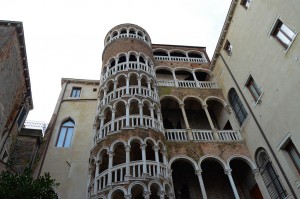 1 – Scala Contarini del Bovolo. Located in a very hidden calle (as Venetian call their streets) and almost impossible to find, these stairs are absolutly breathtaking. The place is a beautiful example of Venetian gothic architecture and it can be dated around the XVI century. The prominent feature of this Palazzo is the multi-arch spiral staircase where you can enjoy an amazing view of the city. And if this stair looks quite familiar, well, Orson Welles used it as the major location for his Othello.
1 – Scala Contarini del Bovolo. Located in a very hidden calle (as Venetian call their streets) and almost impossible to find, these stairs are absolutly breathtaking. The place is a beautiful example of Venetian gothic architecture and it can be dated around the XVI century. The prominent feature of this Palazzo is the multi-arch spiral staircase where you can enjoy an amazing view of the city. And if this stair looks quite familiar, well, Orson Welles used it as the major location for his Othello.
 2 – Libreria Acqua Alta. Book lovers, it’s your turn! Near San Marco Square, you can find one of the best and most original bookshops in the world: Libreria Acqua Alta. Old and new books are stuffed in this two room building where you can find all topics you want, from history to fiction, from cooking books to erotic ones. They are all disposed in a very chaotic way and you need to dig to find what you are looking for. They are even put in bathtubs and gondolas. The owner is a lovely 70 something year old man who can speak several languages and loves to talk about his experiences, his love affairs and his idea to create the bookshop. You might also have close encounter with some cats that sleep peacefully among the books. The most famous attraction is the book stair just outside the shop, a stair you can climb and enjoy the view of the channels.
2 – Libreria Acqua Alta. Book lovers, it’s your turn! Near San Marco Square, you can find one of the best and most original bookshops in the world: Libreria Acqua Alta. Old and new books are stuffed in this two room building where you can find all topics you want, from history to fiction, from cooking books to erotic ones. They are all disposed in a very chaotic way and you need to dig to find what you are looking for. They are even put in bathtubs and gondolas. The owner is a lovely 70 something year old man who can speak several languages and loves to talk about his experiences, his love affairs and his idea to create the bookshop. You might also have close encounter with some cats that sleep peacefully among the books. The most famous attraction is the book stair just outside the shop, a stair you can climb and enjoy the view of the channels.
3 – Bacaro tour. A bacaro is a small bar or osteria in Venice, specialised in serving different types of wine in glasses (called ombra, literally shadow) and cicchetti, small side dishes like tiny sandwiches, fried calamari or boiled eggs and olives. All must be eaten and drunk while standing. A “national sport” is to visit a large number of bacari during the day, called Bacaro tour. If you think you can resist long enough, and you are in Venice, AEGEE-Treviso organises periodically a Bacaro tour for their members and foreign people.
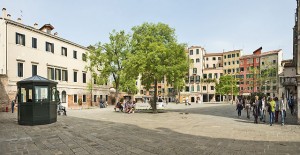 4 – Il ghetto di Venezia. How many times have you used the word ghetto? Have you ever asked yourself what the origin of this name is? It is Venetian, of course. Back to the XIV, a settlement of Venetian jews started to live in the former foundry and where, during nights, gates were closed; the places where gates lied can still be seen. Once one of the richest place in Venice, now the ghetto has seen some changes since the jews population is very small. Walking through the ghetto is a nice experience because different synagogues can still be seen and some monuments reminding all those lost during the Shoha were erected.
4 – Il ghetto di Venezia. How many times have you used the word ghetto? Have you ever asked yourself what the origin of this name is? It is Venetian, of course. Back to the XIV, a settlement of Venetian jews started to live in the former foundry and where, during nights, gates were closed; the places where gates lied can still be seen. Once one of the richest place in Venice, now the ghetto has seen some changes since the jews population is very small. Walking through the ghetto is a nice experience because different synagogues can still be seen and some monuments reminding all those lost during the Shoha were erected.
 5 – Punta della Dogana. There is a place in Venice where you can have an amazing view of the lagoon and you can see amazing sunsets with the waves singing and the most amazing lullaby you can ever imagine. It is called Punta della Dogana or Punta da Màr and it is a triangle shape dock that divides the Gran Canal from the Giudecca Canal. During the Republic Era, it was used for docking and customs as early as the beginning of the 15th century. The modern building, that now hosts some exhibitions, was first started in 16th century.
5 – Punta della Dogana. There is a place in Venice where you can have an amazing view of the lagoon and you can see amazing sunsets with the waves singing and the most amazing lullaby you can ever imagine. It is called Punta della Dogana or Punta da Màr and it is a triangle shape dock that divides the Gran Canal from the Giudecca Canal. During the Republic Era, it was used for docking and customs as early as the beginning of the 15th century. The modern building, that now hosts some exhibitions, was first started in 16th century.
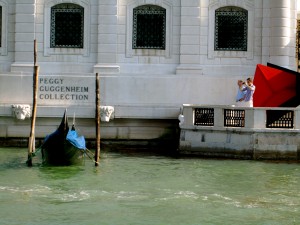 6 – Peggy Guggenheim Collection. Yes, Bilbao building is amazing, not to mention the New York’s one, but the Peggy Guggenheim collection in Venice is the place where history and modern art melt together. Peggy Guggenheim, the famous art collector, lived in Palazzo Venier dei Leoni since 1948 and after her death, she asked to rest there. The collection is rather small, if compared with her sister in Spain and USA, but it has some of the most famous pieces in art history with an unusual view on the Gran Canal. In the garden Peggy’s grave can still be seen, near her beloved pets.
6 – Peggy Guggenheim Collection. Yes, Bilbao building is amazing, not to mention the New York’s one, but the Peggy Guggenheim collection in Venice is the place where history and modern art melt together. Peggy Guggenheim, the famous art collector, lived in Palazzo Venier dei Leoni since 1948 and after her death, she asked to rest there. The collection is rather small, if compared with her sister in Spain and USA, but it has some of the most famous pieces in art history with an unusual view on the Gran Canal. In the garden Peggy’s grave can still be seen, near her beloved pets.
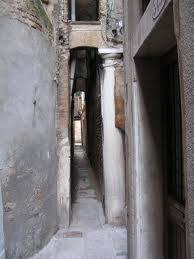 7 – Calletta varisco. Near Campo Widmann, in sestiere Cannareggio, there is a calle that is known as one of the smallest road in the world. It is only 53 cm in length from one side to another. When there, you should stop in the middle of the road and look at the sky. The tiny portion of blue will make you understand why the Argentinian poet Jorge Luis Borges called Venice “a stone jungle”.
7 – Calletta varisco. Near Campo Widmann, in sestiere Cannareggio, there is a calle that is known as one of the smallest road in the world. It is only 53 cm in length from one side to another. When there, you should stop in the middle of the road and look at the sky. The tiny portion of blue will make you understand why the Argentinian poet Jorge Luis Borges called Venice “a stone jungle”.
8 – Eat a lot. In Italy you need to eat and take at least 1.5 kg per day, because there is no place anywhere else where you can taste a delicious food like in the Coutry that looks like a boot. Venice is no exception. As we mentioned before, you should try once cicchetti, but you also should try Fritto-inn, a place where everything is fried and you can taste nice fried fish. If you are a sweet lover, Pasticceria da Tonolo is heaven, especially during Carnival where the famous fritella, filled either with chantilly cream or eggnog, is sold.
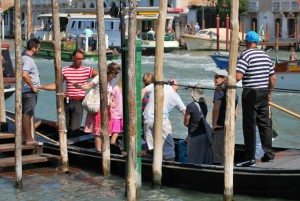 9 – Traghetto. One of the wildest dream of people visiting Venice is to have a gondola ride, but the super high costs of it prevent most of the students to enjoy. Actually you can with only 2 euros. In Venice there are six gondolas that daily connect parts of the isles, mostly crossing the Grand Canal, taking the name of traghetto. it might not be that romantic, but it is still something you should try, especially traghetto di Santa Sofia that connects Strada Nuova with the beautiful (and ancient) fish market.
9 – Traghetto. One of the wildest dream of people visiting Venice is to have a gondola ride, but the super high costs of it prevent most of the students to enjoy. Actually you can with only 2 euros. In Venice there are six gondolas that daily connect parts of the isles, mostly crossing the Grand Canal, taking the name of traghetto. it might not be that romantic, but it is still something you should try, especially traghetto di Santa Sofia that connects Strada Nuova with the beautiful (and ancient) fish market.
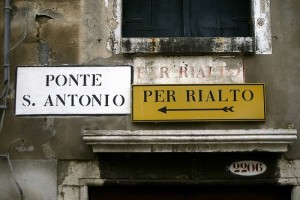 10 – Lose yourself. What a piece of advice, uh? But getting lost in Venice is really difficult because the city is scattered with yellow labels indicating the most famous attractions such as San Marco, Rialto, the Accademia Bridge, Santa Lucia (the railway station), Piazzale Roma (the bus station). For non-inhabitants following those instructions is just fine to discover the city, but if you want to see the real beauty, hidden gardens, the colour of a city like no other, you should just take a random calle and go. Beware that you will walk a lot because the city has over 100 isles connected by zillion of bridges. In case you don’t want to walk, take a vaporetto, the water bus, and step out to a random stop and see what the city is holding up for you.
10 – Lose yourself. What a piece of advice, uh? But getting lost in Venice is really difficult because the city is scattered with yellow labels indicating the most famous attractions such as San Marco, Rialto, the Accademia Bridge, Santa Lucia (the railway station), Piazzale Roma (the bus station). For non-inhabitants following those instructions is just fine to discover the city, but if you want to see the real beauty, hidden gardens, the colour of a city like no other, you should just take a random calle and go. Beware that you will walk a lot because the city has over 100 isles connected by zillion of bridges. In case you don’t want to walk, take a vaporetto, the water bus, and step out to a random stop and see what the city is holding up for you.
If you want to tell 10 things to do, eat and visit in your city (even where there is no AEGEE), you can fill this form. Let’s create a small travel guide for AEGEE people!
Written by Erika Bettin, AEGEE-Verona

